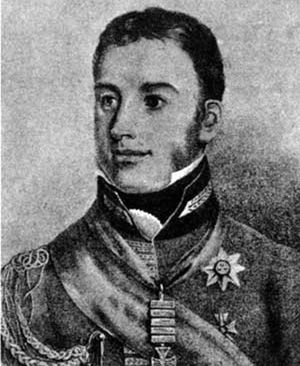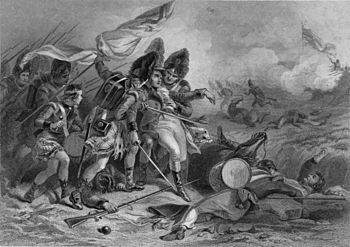Edward Pakenham facts for kids
Quick facts for kids
Sir Edward Pakenham
|
|
|---|---|
 |
|
| Member of the Irish Parliament for Longford Borough |
|
| In office 1799–1800 |
|
| Preceded by | Thomas Pakenham |
| Succeeded by | Thomas Pakenham |
| Personal details | |
| Born |
Edward Michael Pakenham
19 March 1778 Pakenham Hall, County Westmeath, Ireland |
| Died | 8 January 1815 (aged 36) St. Bernard Parish, Louisiana, U.S. |
| Resting place | St. Etchen's Church, Killucan 53°30′49.5″N 7°08′40.3″W / 53.513750°N 7.144528°W |
| Nationality | British |
| Relations |
|
| Parents |
|
| Civilian awards | Knights Grand Cross of the Order of the Bath |
| Military service | |
| Allegiance | |
| Branch/service | British Army |
| Years of service | 1794–1815 |
| Rank | Major General |
| Battles/wars | Irish Rebellion of 1798 |
| Military awards | |
Major General Sir Edward Michael Pakenham (born March 19, 1778 – died January 8, 1815) was a British Army officer and a politician. He was the son of the Baron Longford and was related by marriage to the Duke of Wellington. Pakenham fought alongside Wellington in the Peninsular War. Later, during the War of 1812, he became the commander of British forces in North America. Sadly, on January 8, 1815, Pakenham was killed while leading his soldiers at the Battle of New Orleans.
Contents
Early Life and Start in the Army
Edward Pakenham was born in Ireland at Pakenham Hall, which is now called Tullynally Castle. His parents were Edward Pakenham, the 2nd Baron Longford, and Catherine Rowley. He went to school at The Royal School, Armagh.
When Edward was just sixteen years old, his family bought him a special position as a lieutenant in the 92nd Regiment of Foot. This meant he could become an officer in the army at a young age.
Political Role
From 1799 to 1800, Edward Pakenham also served as a politician. He represented Longford Borough in the Irish House of Commons. This was a part of the Irish Parliament at the time.
Military Career and Key Battles
Pakenham served in the 23rd Light Dragoons. He fought against the French in Ireland during the Irish Rebellion of 1798. After that, he served in other places like Nova Scotia, Barbados, and Saint Croix.
In 1803, he led his soldiers in an attack on Saint Lucia and was wounded. He also fought in the Battle of Copenhagen (1807) in Denmark. Later, he was wounded again while fighting the French in Martinique.
In 1806, his sister Catherine married Arthur Wellesley. Wellesley later became the famous Duke of Wellington.
Fighting in the Peninsular War
Pakenham joined his brother-in-law, the Duke of Wellington, in the Peninsular War. This war was fought in Spain and Portugal against Napoleon's French Empire. Pakenham was an adjutant-general, which is a high-ranking officer.
He commanded a regiment in the Battle of Bussaco in 1810. In 1811, he helped defend the fortress of Almeida in the Battle of Fuentes de Onoro. His actions helped the British win that battle.
In 1812, Pakenham was highly praised for his bravery at the Battle of Salamanca. He led the Third Division and attacked the French army's side, which helped secure a major victory. For his courage and leadership in many battles, he received the Army Gold Cross.
The War of 1812
In September 1814, Pakenham was promoted to Major General. He was asked to take over as commander of the British North American army. The previous commander, General Robert Ross, had been killed.
The most famous battle Pakenham fought in was the Battle of New Orleans. This battle happened in January 1815. While Pakenham was encouraging his troops near the enemy lines, he was hit by a type of cannonball called grapeshot. It badly injured his left knee and killed his horse.
As his senior aide, Major Duncan MacDougall, helped him up, Pakenham was wounded a second time in his right arm. He then got on MacDougall's horse, but more grapeshot hit him in the spine. This wound was fatal. He was carried off the battlefield and died at the age of 36. His last words were said to be instructions for General John Lambert to take command.
The British lost the Battle of New Orleans. The American commander was Major General Andrew Jackson. Jackson later became the seventh President of the United States.
A peace treaty, the Treaty of Ghent, had already been signed on December 24, 1814. However, news of the treaty did not reach the soldiers until weeks after the battle. This meant they were still fighting even though the war was officially over.
The Duke of Wellington was very sad to hear about Pakenham's death. He said that Pakenham "fell as he lived, in the honourable discharge of his duty and distinguished as a soldier and a man."
Legacy and Memorials
There is a statue in memory of Sir Edward Pakenham at St Paul's Cathedral in London. His body was brought back to Ireland in a cask of rum. He was buried in his family's vault in Killucan, County Westmeath, Ireland.
Several places are named after him:
- The village of Pakenham in Ontario, Canada.
- A suburb of Melbourne, Australia.
- Two streets in Chalmette, Louisiana, where the Battle of New Orleans took place, are named Packenham Avenue and Packenham Drive.
In the song "The Battle of New Orleans" by Johnny Horton, Pakenham is mentioned as leading the British. However, the song incorrectly calls him "Colonel Pakeningham" instead of General Pakenham.
See also
- List of Knights Companion of the Order of the Bath
- List of Knights Grand Cross of the Order of the Bath



